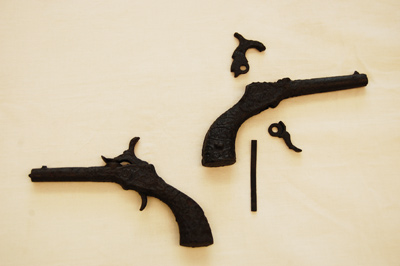Digging Jacksonville – November 2014
During the excavation of the Chinese Quarter by the Southern Oregon University Laboratory of Anthropology (SOULA) in the Fall of 2013, a multitude of fascinating items were uncovered that can shed light on the experiences of Chinese immigrants living in Jacksonville during the late nineteenth century. Among the most curious of these, was two small guns recovered at the lower depths of the excavation near the door of the burned house. Metal conservation showed the artifacts to be cast iron toy cap guns, manufactured in the 1870s. Due to strict immigration laws, very few Chinese children would have been in Jacksonville during this time—so to find children’s toys in the remains of a Chinese household of the time was very unexpected.
As an SOU student working with SOULA, I had the opportunity to work on the restoration and conservation of these artifacts, which were initially corroded to the point that they were almost unrecognizable as toy guns. In order to prevent the oxidization process from continuing to deteriorate the toys, and to ideally uncover details about the guns make or model, I performed electrolysis on them—a process used as a means to restore iron artifacts in the least-destructive manner possible.
Electrolysis essentially consists of placing the artifact to be restored in an electrolyte bath (water with some soda ash was used in this case), and attaching a negative charge to it. Then a piece of “sacrificial” iron (rebar was used here) with a positive charge is submerged as well. When a current is run through the system, the rusted encrustations on the surface of the artifact gradually detach, and become attracted to the sacrificial iron, restoring what remains of the original surface of the artifact.
Beneath the layers of rust, the cap guns were surprisingly well preserved. Both toys had legible model names emblazoned on their sides: one read “Daisy” (with an image of a flower) and the other “UNXLD” (which could be shorthand for “unexcelled,” a popular firework brand in those days). With this information we were able to get a relative date as to when each was manufactured, and those dates aligned perfectly with the known occupation of the house, which burned to the ground in 1888.
Questions surrounding why these toys were found in the house have yet to be answered, but one interpretation is that they may have been being used as noisemakers instead of, or in conjunction with the firecrackers common in nineteenth century Chinese celebrations. When Chinese supplies were unavailable, items sold in Jacksonville stores might have been creatively reused to replace or supplement traditional wares. Artifacts such as these cap guns allow us to see some of the ways people adapt to changing cultural environments, reinforcing the creative ways in which people are able to maintain important traditions while embracing new ideas and technology.
Thank you to ODOT and the City of Jacksonville for underwriting the excavations in the Chinese Quarter Site.

 Kyle Crebbin received his B.S. in Anthropology from SOU, and is working with SOULA until he begins graduate school at the University of Nevada, Reno next fall 2017. You can reach SOULA by contacting Chelsea Rose at rosec@sou.edu and follow SOULA on
Kyle Crebbin received his B.S. in Anthropology from SOU, and is working with SOULA until he begins graduate school at the University of Nevada, Reno next fall 2017. You can reach SOULA by contacting Chelsea Rose at rosec@sou.edu and follow SOULA on